Navigating Florida’s Divorce Process: Essential Steps for a Peaceful Separation
Originally published: June 2025 | Reviewed by Carol Ann Mazza

Divorce in Florida can be overwhelming, especially if someone has never faced legal processes before.
Confusion about paperwork, court steps, and legal rights is common, but reliable information can make the journey much smoother.
Understanding the basics and each step involved can help individuals approach Florida’s divorce process with clarity and confidence.
Whether a divorce is simple or more complex, knowing Florida’s legal requirements and what to expect at each stage is key.
The right guidance will help separate fact from myth, making it easier to make informed decisions.
With the help of straightforward checklists and directions, anyone can navigate the essential steps and avoid unnecessary stress.
Key Takeaways
- Learn essential facts before starting a divorce in Florida.
- Understand each step, from filing to the final judgment.
- Be aware of the documents and issues to prepare in advance.
Florida Divorce Basics: What You Must Know Before Filing

To file for divorce in Florida, specific rules must be met.
These include the state’s no-fault approach and strict residency guidelines that determine who is legally eligible.
Florida Is a “No-Fault” Divorce State
Florida uses a no-fault divorce system.
This means neither spouse has to prove that the other did anything wrong, like adultery or abandonment, to end the marriage.
Instead, the only reason needed is that the marriage is “irretrievably broken.”
In rare cases, a spouse may use “mental incapacity” as the reason, but most people simply say the marriage cannot be fixed.
This helps reduce conflict and the need for personal accusations.
Neither side is at fault, and personal details that contributed to the breakdown are not required in court documents.
Since Florida is a no-fault state, it does not matter who chose to end the relationship.
The court’s main focus becomes dividing assets, establishing support, and handling child-related issues, not who caused the breakup.
This can make the process less stressful and more straightforward.
Residency Requirements and Legal Eligibility
Before a divorce case can begin, at least one spouse must meet the Florida residency requirement for divorce.
The law states that one spouse must reside in Florida for at least six months before filing the divorce petition.
This must be proven with documents such as a Florida driver’s license, voter ID, or testimony from a third party.
If neither spouse meets the residency requirement, the court will not accept the case.
Even if both spouses agree to divorce, living outside Florida within the last six months means the filing must wait.
These rules apply to every type of divorce, including both contested and uncontested cases, and are strictly enforced as of 2025.
Anyone planning to get divorced in Florida should first check their or their spouse’s current residency status.
Choosing the Right Divorce Path in Florida
Florida residents considering divorce should be aware of the various options available to them.
Each option depends on the couple’s situation, level of agreement, and willingness to work together to avoid a lengthy court battle.
Contested vs. Uncontested Divorce
A contested divorce occurs when spouses cannot agree on important matters, such as child custody, division of property, or financial support.
These cases are often decided by a judge in family court, leading to a longer and sometimes more stressful process.
The court process can involve multiple hearings, incur substantial legal fees, and result in months of waiting for a decision.
In contrast, an uncontested divorce means both parties agree on all divorce-related issues before filing. This path is generally faster and more affordable.
Florida law allows couples to file for an uncontested divorce by submitting a written agreement that outlines all terms.
This way, they can avoid lengthy disputes and may even finish the process without attending multiple court appearances.
An uncontested divorce is the most common way for couples in Florida to dissolve their marriage without going through a court trial.
This no-fault system simplifies things if both sides are cooperative and communicative.
The Collaborative Divorce Option
Collaborative divorce gives couples a private, team-based approach. Each spouse hires a specially trained attorney, and sometimes other professionals, to help them reach an agreement outside of court.
This option keeps details about the divorce confidential and lets the couple control the process.
The collaborative approach is recognized by Florida law. It emphasizes respect, honest communication, and effective problem-solving.
Meetings are held outside the courtroom, and both attorneys agree not to go to court. If the collaborative process fails, new lawyers must be hired before going to trial.
Families seeking less conflict and greater privacy often opt for collaborative divorce.
It offers a court-free divorce in Florida, reducing stress and putting both spouses on equal footing during negotiations.
Mediation as a Court-Approved Alternative
Mediation is a cost-effective and flexible way for spouses to settle disputes.
A neutral mediator helps both sides discuss and resolve difficult issues, such as parenting plans and property division.
Mediators do not make decisions—they assist the couple in reaching a mutually agreed-upon agreement.
Florida’s family courts often recommend or require mediation before letting contested cases move to trial.
Mediation can be utilized at any stage of the divorce process. If the court approves it, the agreement reached is legally binding.
This process is less formal than a traditional court hearing, and meetings can be scheduled at convenient times.
The divorce mediation process in Florida helps many couples save money, reduce conflict, and find solutions tailored to their needs.
Want a peaceful divorce without court battles? CollaborativeNow helps Florida couples resolve everything respectfully through collaborative divorce. Please contact us to schedule your initial conversation.
If you’re ready to get started, call us now!
Step-by-Step Breakdown of Florida’s Divorce Process

A Florida divorce proceeds through specific steps established by the state.
Each person filing should be familiar with the rules, forms, and timelines to avoid mistakes and stress.
Step 1 – Filing the Petition
The process starts with filing a “Petition for Dissolution of Marriage” at the circuit court in the county where either spouse lives.
In Broward County, this means submitting the correct forms at the county courthouse.
The person who files first is referred to as the “petitioner.”
The initial petition must clearly outline the marriage’s basic facts, any property claims, and, if necessary, requests regarding child custody and support.
Filing fees apply. Fee waivers may be available for those who cannot afford them. Once filed, the petition initiates the Florida divorce process.
The court assigns a case number, and the case becomes part of the public records unless it is sealed.
Step 2 – Serving the Other Spouse
The next key step is “service of process.”
This means officially notifying the other spouse, now referred to as the “respondent,” about the case. Service is usually done by a sheriff or a certified private process server, not the person filing.
The respondent must receive copies of the petition and a summons directly. The petitioner cannot hand them the papers.
Proof of this delivery is filed with the court.
If the respondent cannot be found, the court has rules for “constructive service,” which may involve posting notice in a local newspaper.
The process ensures that both sides are aware that the divorce has started and have a chance to respond within the court’s timeline, which is typically 20 days.
Step 3 – Financial Disclosures
Both spouses are required by Florida law to give each other financial paperwork.
This includes a financial affidavit, the last few years of tax returns, recent pay stubs, bank account statements, and documents showing debts or assets.
Complete and honest disclosure is not optional.
Each side has 45 days from the date the papers are served to exchange these documents.
Penalties exist for failing to disclose or share required information.
This disclosure helps resolve support, asset division, and debt responsibilities.
Maintaining accurate records and sharing details on time can streamline the process and help prevent court sanctions or delays.
Step 4 – Parenting Plan Submission (If Children Involved)
If minor children are part of the marriage, Florida law requires a detailed parenting plan.
This plan outlines schedules, parental responsibilities, holiday sharing arrangements, and guidelines for making decisions on behalf of the child.
Both parents must attempt to agree on a schedule. If they cannot, each can submit their plan. Parenting classes are required for divorcing parents.
These plans should adhere to Florida divorce parenting plan rules, focusing on what is in the best interest of the child.
The court reviews the plan to ensure it is fair and serves the child’s needs.
Final approval from a judge is needed before the divorce is granted.
Step 5 – Settlement or Trial
Most Florida divorce cases settle out of court. Couples often attend mediation to discuss and resolve issues such as property, debts, support, and parenting arrangements.
If an agreement is reached, they write a settlement agreement and submit it for the judge’s approval.
Settlements move the process forward much faster than a trial. If the couple cannot agree, a trial is set.
Both sides present evidence and testimony in court, and the judge makes the final decisions on all points.
Preparing well for either mediation or trial helps each side protect their rights and reach a fair outcome.
Step 6 – Final Judgment of Dissolution
The last step is the court’s issuing of the Final Judgment of Dissolution of Marriage. The judge reviews all agreements, forms, parenting plans, or trial outcomes.
If everything is in order, the judge signs the order, making the divorce official. The court may also decide support, property division, and timesharing.
After the judgment, both parties receive a certified copy for their records. This document serves as proof that they are legally divorced and can make changes, such as reverting to a former name if requested.
Once divorced, each person must update their legal records, financial accounts, and any parenting or support arrangements as soon as possible.
Stuck on parenting or finances? CollaborativeNow offers confidential divorce mediation to help you move forward without going to court. Book a consultation with us today.
If you’re ready to get started, call us now!
Key Legal Issues Addressed During Divorce
Florida divorce cases involve several important legal matters. These include dividing property fairly, awarding financial support if needed, setting child support, and understanding special rules for parents.
Property Division – Equitable, Not Equal
Florida follows an “equitable distribution” rule when splitting property. This means property and debts are divided fairly, but not always equally.
Judges consider factors such as the length of the marriage, each spouse’s income, and their contributions, including childcare and household responsibilities.
Property includes real estate, bank accounts, retirement plans, and personal belongings. All assets and debts gained during the marriage are considered “marital property.”
Items owned before marriage or after a legal separation typically remain with the original owner. Florida does not recognize legal separation, so only assets acquired before or after marriage are considered separate.
If both parties reach a fair agreement, the court will often approve it. If not, the judge decides what is fair in each situation.
Spousal Support (Alimony) – 2023 Reform
Florida updated its alimony laws in 2023. Permanent alimony is no longer allowed.
Now, the court awards only temporary and bridge-the-gap alimony, rehabilitative alimony, or durational alimony, each with different time frames and purposes.
Judges consider factors such as the length of marriage, financial need, age, earning ability, health, and standard of living when determining alimony. Payments are intended to help a spouse adjust after divorce, not to become a permanent source of income.
Changes in income, remarriage, or other significant life events can result in adjustments to alimony after divorce.
Both parents should be aware of these new rules, especially if they expect to pay or receive support.
Child Support – Florida Income Shares Model
Florida uses the “income shares model” to set child support. The court adds the combined incomes of both parents and then determines the cost of supporting the child.
Each parent pays a share, based on their percentage of the total income.
Key factors include:
- Number of children
- Cost of health insurance
- Childcare expenses
- Parenting time (overnights)
- Special needs or education costs
The goal is to ensure that children have the same level of support they would if the family were living together. Parents can agree on a plan, but it must be approved by the court.
Florida law allows for post-divorce changes when incomes or needs change.
Required Documents and Court Filings Checklist

Florida’s divorce process requires completing certain legal forms and paperwork. Moving through this list step by step helps make the process more manageable and reduces the risk of delays.
Mandatory Forms
The first step is filling out the Petition for Dissolution of Marriage. This document starts the divorce and must be filed with the court.
Both parties should also complete a Family Law Financial Affidavit to outline their income, assets, debts, and expenses.
Required forms include:
| Form Name | Purpose |
| Petition for Dissolution of Marriage | The divorce officially starts |
| Summons | Notifies the other party of the filing |
| Family Law Financial Affidavit | Statement of income and finances |
| Notice of Social Security Number | Lists social security numbers for both parties |
| Marital Settlement Agreement (if any) | Division of property, assets, and debts |
In some counties, additional forms may be required.
Optional or Case-Specific Documents
Some documents are only needed based on the situation. Couples with children must add a Parenting Plan, which explains custody, visitation, and decision-making responsibilities.
If child support is an issue, a Child Support Guidelines Worksheet should be filed.
Documents may also be required to manage specific assets, such as property deeds or retirement account statements.
If there are disagreements, filings such as a Request for Temporary Relief may be applicable for issues like temporary child support or spousal support.
Cases involving unique circumstances, like domestic violence or out-of-state assets, often call for extra paperwork. Checking county requirements and seeking legal advice helps ensure that these forms are included.
Timeline and Cost of Divorce in Florida
The duration and cost of a divorce in Florida depend primarily on whether it is contested or uncontested.
Average Divorce Timeline
An uncontested divorce in Florida is often the fastest route. When both spouses agree on key points, such as property, custody, and support, the process typically takes about 2-3 months from start to finish.
It often takes 3 weeks just to prepare the papers before filing. Once filed, there may be a short waiting period, but things can move quickly if there are no disputes.
For contested divorces, the timeline is much longer. Disputes over money, property, or children can drag out for months or even years.
Complex cases, full trials, and court delays often cause these longer waits.
Estimated Costs Based on Process
Costs in Florida divorce cases vary depending on the type of divorce and whether lawyers are involved. An uncontested divorce is often the most cost-effective option.
Most people pay between $500 and $1,500 for simple cases, which includes filing fees and basic assistance from a lawyer.
A contested divorce usually costs much more. With court hearings, lengthy negotiations, and additional paperwork, the final price can easily reach $5,000 to $10,000 or higher.
Attorney fees are often the biggest expense. Mediation, expert witnesses, and extra filing fees add to the cost.
Not sure where to begin? This quick-start checklist outlines what you’ll need to do from filing to final judgment.
Florida Divorce Process Checklist
Use this checklist as a practical guide to help you stay organized throughout your divorce process in Florida.
| Step | Action Item |
| Step 1: Confirm Residency | Make sure you or your spouse has lived in Florida for at least 6 months before filing. |
| Step 2: Choose Divorce Path | Decide between contested, uncontested, collaborative, or mediated divorce based on your situation. |
| Step 3: File the Petition | Submit the “Petition for Dissolution of Marriage” in the appropriate circuit court. |
| Step 4: Serve the Other Spouse | Ensure your spouse is officially served by a sheriff or certified process server. |
| Step 5: Exchange Financial Documents | Share financial affidavits, bank statements, tax returns, and proof of income within 45 days. |
| Step 6: Create a Parenting Plan (if kids) | Draft a detailed parenting plan and complete the required parenting course. |
| Step 7: Mediate or Negotiate a Settlement | Use mediation or collaborative meetings to resolve property, support, and custody. |
| Step 8: Prepare and Sign Agreement | Complete a written marital settlement agreement if terms are agreed upon. |
| Step 9: Final Court Review | Attend hearing (if needed) and have the judge sign the Final Judgment of Dissolution. |
| Step 10: Post-Divorce Updates | Update legal records, accounts, and support arrangements after the judgment is entered. |
Need help finalizing your divorce or adjusting agreements? CollaborativeNow guides you through every post-divorce step with care and clarity. Reach out now to schedule.
Contact Us Today For An Appointment
Frequently Asked Questions
How do I start the divorce process in Florida?
To start a divorce in Florida, one spouse must file a Petition for Dissolution of Marriage with the circuit court. You must meet the 6-month residency requirement and serve your spouse with the petition, as required by Florida Statutes § 61.021 and § 61.052.
What are the steps to get divorced in Florida?
The Florida divorce process includes filing, serving your spouse, financial disclosures, negotiating terms, and obtaining a Final Judgment. Mediation or collaboration may resolve disputes before trial, especially in uncontested cases.
How long does a divorce take in Florida?
An uncontested divorce in Florida may take 3 to 6 months. Contested cases involving court hearings can take 12 months or more. Collaborative divorces often resolve within 4 to 9 months, depending on their complexity and the level of cooperation.
What is the difference between contested and uncontested divorce?
A contested divorce involves disagreements that must be resolved in court, while an uncontested divorce means both spouses agree on all terms. Uncontested divorces are faster, less expensive, and less stressful.
Do I need a lawyer to file for divorce in the state of Florida?
You don’t need a lawyer to file for divorce in Florida, but legal help is highly recommended—especially if children or assets are involved. Self-representation is allowed but carries risks if you’re unfamiliar with family law.
What’s the role of mediation in Florida divorce?
Mediation helps divorcing spouses resolve issues without going to trial. Florida courts often require mediation before contested hearings. It’s a confidential, cost-effective way to reach agreements on parenting, finances, and property.
What is collaborative divorce, and how does it work in Florida?
Collaborative divorce is a no-court option where spouses work with trained professionals to reach mutual agreements. Under Florida Statutes § § 61.56–61.58, both parties agree to resolve disputes respectfully and privately, utilizing attorneys, coaches, and financial neutrals.
